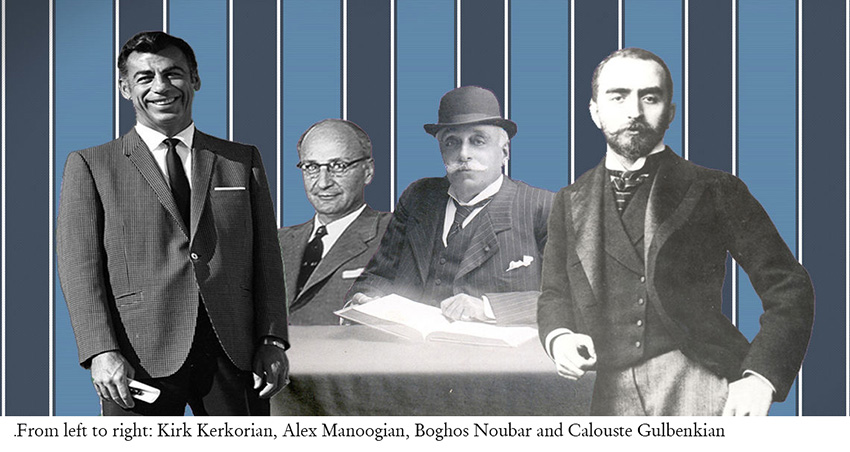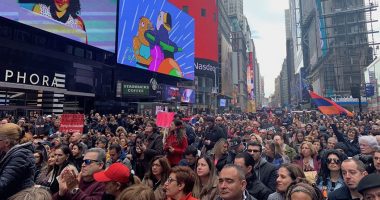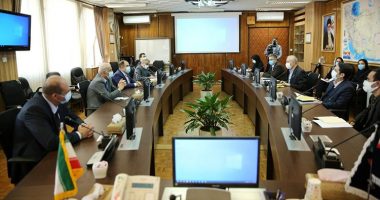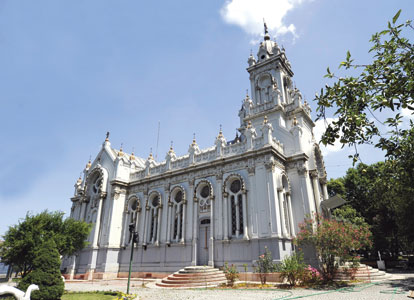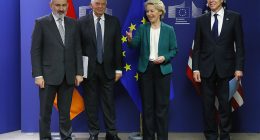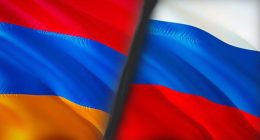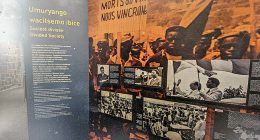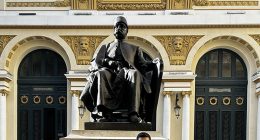EVN Report — In recent years a new discourse on “global Armenians” is increasingly becoming part of an effort of constructing a post-Genocide Armenian identity in the Diaspora — and Armenia. These new identity shapers seem to advocate a transition from “survival mentality” to celebration of life and success. One definition was provided in a full-page letter published in The New York Times (28 October 2016), according to which a “global Armenian” is someone, who despite having “forcibly displaced and dispersed” ancestry, lives “across the world” and has made or is making “major contributions toward advancing their adoptive countries.”[1] Such “global Armenians” include scientists, doctors, engineers and inventors making contributions to societies in their countries; politicians, ministers and diplomats serving in different countries; movie stars, sportsmen, bankers and corporate executives; and, of course, celebrities who have millions of followers on social networks. In short, a “global Armenian” is someone who is professionally successful, has an impact in their field, and has public visibility or recognition.
One of the stated main goals of this prescriptive “global Armenianism” is “to transform the post-Soviet Armenian Republic into a vibrant, modern, secure, peaceful and progressive homeland for a global nation.” This is, indeed, a vision that many in Armenia and the Diaspora dream about. Of course, there are others who use the term “global Armenian” as a descriptive term or as synonym for dispersion.[2]
Yet, even as “global Armenians” seem to be thriving around the world, they don’t seem to be thriving in the Republic of Armenia. With rare exceptions, global Armenians seem to exist everywhere except in Armenia. Instead, Armenia is visible through its oligarchs — a small number of people who have political, economic, social and even cultural and religious power that survives through unquestioned loyalty, pubic obedience or oppression. President Serzh Sargsyan himself affirmed at the opening of the 6th Parliament, when he said: “indeed, today, the face of corruption [in Armenia] has changed,” underlining that it is “increasingly becoming more visible and untenable.”[3]
No, the vast majority of Armenians in Armenia and the Diaspora are not successful “global Armenians,” as defined by the evangelists of this “new” concept. Twenty-seven years after the Earthquake in northern Armenia, some 3,000 Armenians still live in temporary shelters. More worrying, one third of Armenia’s population is poor. There are 900,000 poor people in Armenia, according to the official figures provided by the State Statistical Services. World Bank defines poverty as “the inability to ensure an acceptable minimum of certain living conditions.” In fact, poverty increased by 2.3 percent between 2008 and 2015.” A government report explains that “the number of the poor in 2015 was around 900,000, of whom around 310,000 were very poor, and of the latter around 60,000 were extremely poor.[4] Meanwhile, in the Diaspora, there are thousands of Syrian Armenian refugees in Lebanon alone, facing myriad of needs and uncertainties.
Global Armenians, like the ocean-crisscrossing Armenian merchants of the 16th-18th centuries, might have preserved colonies or continue to keep communities spread across the world vibrant, even as they face the risk of assimilation spread over generations. However, preserving a nation is not the same as preserving a community. The homeland, Armenia, is the guarantor of the continuation of Armenians as a viable nation. Boghos Noubar, Calouste Gulbenkian, Alex Manoogian and Kirk Kerkorian, for example, are exceptions, but rich organizations and successful global Armenians are not collectively as rich to preserve a country. Successful individuals alone rarely create state institutions which are critical for societal prosperity. National institutions are created with the participation, engagement and involvement of the larger society. Working together on specific projects or towards common goals is different from “unity” or “united” activities, often repeated terms in Armenian discourse, but virtually never fulfilled.?
A nation becomes prosperous when all segments of society ? with their talents, capabilities, and wide range of resources ? are engaged in the process of building a preferred future. In the last century, we have been successful in building prosperous communities and preserving Armenian identity in the Diaspora. In the last 25 years, we have been engaged in the process of state-building. But what we have yet to complete is the process of nation-building – a process that is not the mere endeavor of individuals or a certain group of people, but a long-term collective project. We could view nation-building as the process of fulfilling or taking the efforts started in the Diaspora in the last one hundred years and since Armenia’s independence to their “logical conclusion.” In short, national-building is the construction of an Armenian national identity through the power of the Armenian state.
And this brings us to the main question: Could Armenians remain a global nation with a broken homeland? A homeland plagued with poverty, corruption and depopulation?
Even as we should celebrate and promote global Armenianism — a mark of regeneration and integration into global society — we need to be cautious about the temptation to brush aside the real problems facing the Armenian nation. Individually, Armenians have been very successful, they have become global citizens; but institutionally, our collective life bears the shackles of at least three factors:
(a) the past — we do a lot of retrospection, but very little prospection; (b) lack of a “national philosophy” — or a set of common values around which we could gather collectively; and (c) transformative leadership — we have many leaders, but seem to lack leadership. Let me elaborate these three issues.
a) The past: Change of perspective
First, I suggest that we need a major shift of perspective in our national discourse from the past to the future. The past, our glorious and not so glorious history, rather than the future seem to be determining what we ought to do in the present. In this sense, the wise remarks of the late Catholicos Karekin I of All Armenians are instructive: “The glorification of the past does not mean turning the past into a worship idol. If we continue to glorify the past to a point that we are filled and drunken by it …we would betray the past…. We are a ring on that chain [of history] which is the march of our life, spread over the centuries and striving towards the infinite future.”[5]
Seeing the present from the future does not mean looking into a crystal ball, but seeing the impact and consequences of our own actions and inactions today on the future, as well as determining where we wish to go in the coming years and decades. For instance, according to United Nations projections, in 2050 Armenia’s population will go down to 2.7 million and in 2100 down to about 1.8 million. While Russia and Georgia will also see decline in their population numbers, Turkey, Azerbaijan and Iran will see natural growth.[6] We know now what will happen to Armenia’s population in 30, 40, 50 years. Twenty years ago, we knew what impact the oligarchic system would have on Armenia’s population and the country’s economic development; and we can be sure what we could expect in 5-10 years if the current system of governance in Armenia continues. It is in this perspective that we need to look at the present from the future.
Secondly, we need to see Armenia and “global Armenianism” in the context of critical global developments. As Klaus Schwab, founder and executive chairman of World Economic Forum, described, we live in a world where “societal polarization, income inequality and the inward orientation of countries are spilling over into real-world politics.”[6] Tectonic shifts in politics, economics and social upheavals are reshaping international relations. These changes have far reaching impact on how countries relate to each other and how risks are managed. In the last few years, the world has seen a continued slow economic growth. Coupled with high debt and demographic changes, this has resulted in financial crises and growing inequalities. Armenia, as well as Armenian philanthropists and philanthropic organizations, are not immune to the risks brought by these shifts.
Ideologically speaking, neoliberalism ? unregulated or slightly regulated capitalism ? is under attack in many quarters around the world as a “failed” ideology. Neoliberal policies of the past decades have created inequalities in societies. These inequalities challenge the very foundations of democracy, as we have seen in Armenia and the rest of the world: the wealthy and the powerful have greater influence on politicians, political representation, policy making and public discourse than the vast majority of citizens.
Meanwhile, technological advancements ? “the Fourth Industrial Revolution” ? are transforming societies, economies, and ways of doing business in ways never seen before. These have positive benefits for societies but also unforeseen consequences. Even as globalization has blurred personal and societal identities, many societies are addressing such anxieties by reasserting their personal and collective identity. International relations are becoming less cooperative and more inward-looking. Emotions, rather than rationality, are informing decision-making and political positioning.
We need to look at our present from the perspective of the future of technology. We know that in the short- and medium-term, for example, Artificial Intelligence, Virtual Reality, 3D printing and such unprecedented technologies would become “positive disruptions”. What are the benefits and uses of such technological “disruptions” for Armenia and Armenians? What are the risks for jobs, such as bank tellers, factory workers, traders and many other positions in the economy? As The Economist wrote, “it is not foolish to believe that 3D printing will power the factories of the future.”[8] In a post-hardware world, which is a topic of discussion these days among specialists, “the intelligence in the machines, rather than the machines themselves” would be the centre of attention.[9] These would certainly have uses for and impact on education, cultural production, trade and industry, defense of borders, so on.
The global risks and socio-political and technological trends that drive them are opportunities for responsive leadership. In the Armenian case, a leadership that would aim to uplift society towards long-term prosperity by engaging and collaborating across stakeholder groups, multiple interconnected systems, areas of expertise and talents.[10] For at least two decades now, we often speak about the lack of adequate leadership or lack of will in Armenia and Diaspora to improve “the state of the nation.” I believe, leadership alone is not enough. What we critically lack is a clear and common understanding of our national “values” ( արժէհամակարգ ). What are our most important national values?
b) National values
Throughout history, I suggest, three pillars have been significant and constant in the Armenian national ethos: church, school, and books (intellectual production) ? in modern terms: spiritual/moral values, education, and communications. These three pillars or institutions have defined, maintained and developed Armenian identity, especially in the Diaspora for at least the last three centuries.
In the globalised world of the 21st century and with Armenia’s independence, these proven identity pillars have been going through a period of transition and need renewal. While today the Church, more precisely the church leadership is failing to provide the spiritual, moral and ethical grounding for Armenian identity and national life, there is a need for a “new philosophy” that is based on millennia rich Armenian wisdom, moral, ethical, social and cultural values that have sustained our national life, especially in times of great crises and transition.
Today, the “elephant in the room” that the leadership neither in Armenia nor in the Diaspora are willing to see or acknowledge is the absence of a “national philosophy” ? a “philosophy” in the widest sense, particularly its moral and ethical dimensions. As the experience of the last 25 years shows, political and economic development, social cohesion, basic social justice, etc. would remain problematic without the adoption, promotion and exercise of sets of moral/ethic values ? values that are both universal and Armenian. In short, what are the value components of Armenian identity?
Armenians like to compare themselves often with Israel and the Jews or with other European nations. Let us look at a few examples of values that are upheld by various societies. In Denmark, for instance, Danish values and philosophy are woven around the idea of interdependence in society. Their sense of “safety and comfort” comes from the surety that material and psychological benefits of living in a society are tangible and accessible. In the “Danish way of thinking” having a secure life is more sensible than taking big risks. Sharing and community are complemented with the feeling of security and, thus, “the ideal of the welfare state.” In Singapore, values such as integrity, resilience and teamwork ? respecting and valuing “every individual and their contribution” are among the sets of values that provide guidance to individuals and organizations. As for the Jews, for example, in a 2012 Jewish Values Survey, when asked what informed their political beliefs and activity, 8-in-10 American Jews said “pursuing justice (84%) and caring for the widow and the orphan (80%); another 55% said “seeing every person as made in the image and likeness of God.”[11]
Interestingly, according to a recent PEW Research Centre survey of religious beliefs and national belonging in Central and Eastern Europe, Armenians scored the highest in a few categories among 18 countries. Armenians tend to be more philosophical than their neighboring countries: 79% in Armenia say they “often think about the meaning and purpose of life”; 57% “feel a deep connection with nature and Earth; 83% “believe in fate” and 72% in “miracles” ? the highest among the surveyed nations.[12]
What are or should be the basic values that would provide a common denominator for Armenians. This is the million-dollar question and one of the most complex and complicated problems. I believe, answers to such questions should be the result of a process of collective and public thinking, discernment and deliberations.
I do not have a ready answer, but I would start with two items ? the other two pillars I noted above. Throughout our history, education, the school, has been one of the most significant institutions in our national life. Education (“love of wisdom”) is part of our national fabric: from the 5th century Golden Age to medieval Armenian monastic “universities” (like Tatev and Haghpat) to the establishment of schools as priority for survival after the Genocide and so on. Education, as we know from experience, is not just schools, but a wider project that includes instilling values, character building, etc. In short, education is the process or vehicle by which the “national philosophy” is transmitted and made a living experience.
Finally, the third pillar is communications. From the ancient manuscripts to tens of thousands of newspapers, magazines, periodicals throughout the last few centuries, communications has been the glue that has bound the Armenian nation together ? intellectually, morally and experientially. In the absence of statehood, transmission of knowledge and values through print media has been part of our national fabric. Today we have wider opportunities with new technologies to reach millions of Armenians rather than only pockets of Armenians or local communities in the past.
In brief, any serious, transformative approach to our national life must include these proven pillars that would define the “new Armenia” in the 21st century. If we are to see progress in the coming years, a holistic approach to the development of Armenian national life is necessary ? for instance, it has become very clear that you cannot leave politics out of the equation of Armenia-Diaspora relations. While the economic and humanitarian aspects have been well studied areas for national development, there has been virtually no discussion about our “national philosophy” ? which would be driven by education and communications ? that connects our present “values” to the past and builds a preferred future.
c) Leadership: What needs to be done?
Over the last 25 years, external and objective problems have been imposed on Armenia and Armenians. However, internally, one of the most critical problems for the prosperity of the country has been the lack of responsive and responsible leadership – not lack of leaders, but leadership. Civil society, in both Armenia and the Diaspora, is not involved in the decision- and policy-making processes. Diaspora institutions ? churches, parties, community organizations ? rarely involve their wider membership or the wider community in their decision-making. Generally, independent professionals, experts, academics, businesspeople are ignored, unless it is for their financial contributions or limited input.
The first step towards building consensus around a “national values/philosophy” is to create a visionary and transcending leadership, which would articulate and address the most critical national issues. Such a step would bring together the knowledge, experience, talents and resources of a wide range of individuals, institutions and seemingly disconnected but equally well-meaning organizational and community leaders. The aim should be transcending personal or organizational agendas for the greater good of the homeland and Armenians around the world.
I believe, three categories or groups of people need to come together in order to overcome the failures of such attempts in the past. The three categories are, what I call, the thinkers, the doers and the makers.
-Thinkers ( մտաւորականներ ): intellectuals, academics, professionals, activists who are independent of loyalties to parochial agendas and have a track record of objective approach to national issues.
-Doers ( վարչականներ): elected or appointed executives of organizations that have impact and influence in the Armenian world.
-Makers ( նիւթական միջոցներու տէրեր ): visionary individuals who have or control considerable financial and organizational resources, who value collective efforts for long term benefits over gratifying short term successes.
Of course, there have been many attempts in the past and there are some pan-Armenian organizations that do a lot of good for Armenia and Armenians. However, virtually none has been able to articulate, implement and engage Armenians around a national “philosophy” for the 21st century. There are, indeed, lessons that could be learned from past successes and failures.
If we are to remain a global nation, we need to fix our homeland by drawing strength and lessons from the past, but must look at the present from the perspective of the future. In this process, we need to pay attention to our axiology and cultural values to complement and strengthen our efforts towards economic prosperity and, especially, political leadership.
The ultimate challenge is how do we make collective ideas, values and directions towards a preferred future come to life in our national life?
*This is a shorter version of a paper presented at ARPA Institute’s 25th Anniversary Conference, entitled “Armenia in the 21st Century: A Strategy for Long-Term Development,” held in Los Angeles, 15 July 2017.
Notes
[1] “The Future for Global Armenians is Now”, published as an advertisement in The New York Times, https://auroraprize.com/en/news/detail/10454/future-for-global-armenians-is-now (18 May 2017). See also “50 Global Armenians”, Mediamax.am, http://www.mediamax.am/en/news/50-global-armenians/10608/ (18 May 2017).
[2] For example, the suggestion of an “emerging global Armenian society.” http://armenianweekly.com/2014/09/08/ani-narod/.
[3] « Ազնվություն, գումարած պրոֆեսիոնալիզմ, հանած կոռուպցիա. Սերժ Սարգսյանի հաջողության բանաձեւը», Armtimes.com, May 18, 2017, http://armtimes.com/hy/article/112398.
[4] National Statistical Service of the Republic of Armenia, “Part 1 – Armenia: Poverty Profile in 2008-2015,” published in 2016: 37-38. http://www.armstat.am/file/article/poverty_2016_eng_2.pdf .
[5] Գարեգին Ա. Կաթողիկոս Ամենայն Հայոց,Կեանքը ի Հաղորդութեան ընդ Աստուծոյ, Լոնտոն, 2015, 56.
[6] “The Global Risks Report 2017, 12th Edition,” World Economic Forum, Geneva, 2017: 4.
[7] https://www.weforum.org/agenda/2017/02/don-t-give-up-on-europe/
[8] “The factories of the future,” The Economist, 1 July 2017: 19.
[9] Richard Waters, “Google turns to Assistant as it strives for edge in AI evolution,” Financial Times, 6 October 2016, p. 21.
[10] “The Global Risks Report 2017, 12th Edition,” World Economic Forum, Geneva, 2017: 4.
[11] “Denmark?the country, its mentality, lifestyle, values” http://www.limbistraine.com/ro/cercetare/ Gabriela-Sauciuc/2. Denmark-Country-mentality-lifestyle-values.html#_ednref7 ; “Vision, Mission and Values”, https://www.mfa.gov.sg/content/mfa/aboutmfa/ vision_mission_values.html; Robert P. Jones and Daniel Cox, Chosen for What? Jewish Values in 2012, Public Religion Research Institute, 2012: 2.
[12] Pew Research Center, Religious Belief and National Belonging in Central and Eastern Europe, pewresearch.org, 2017: 81, 96.

